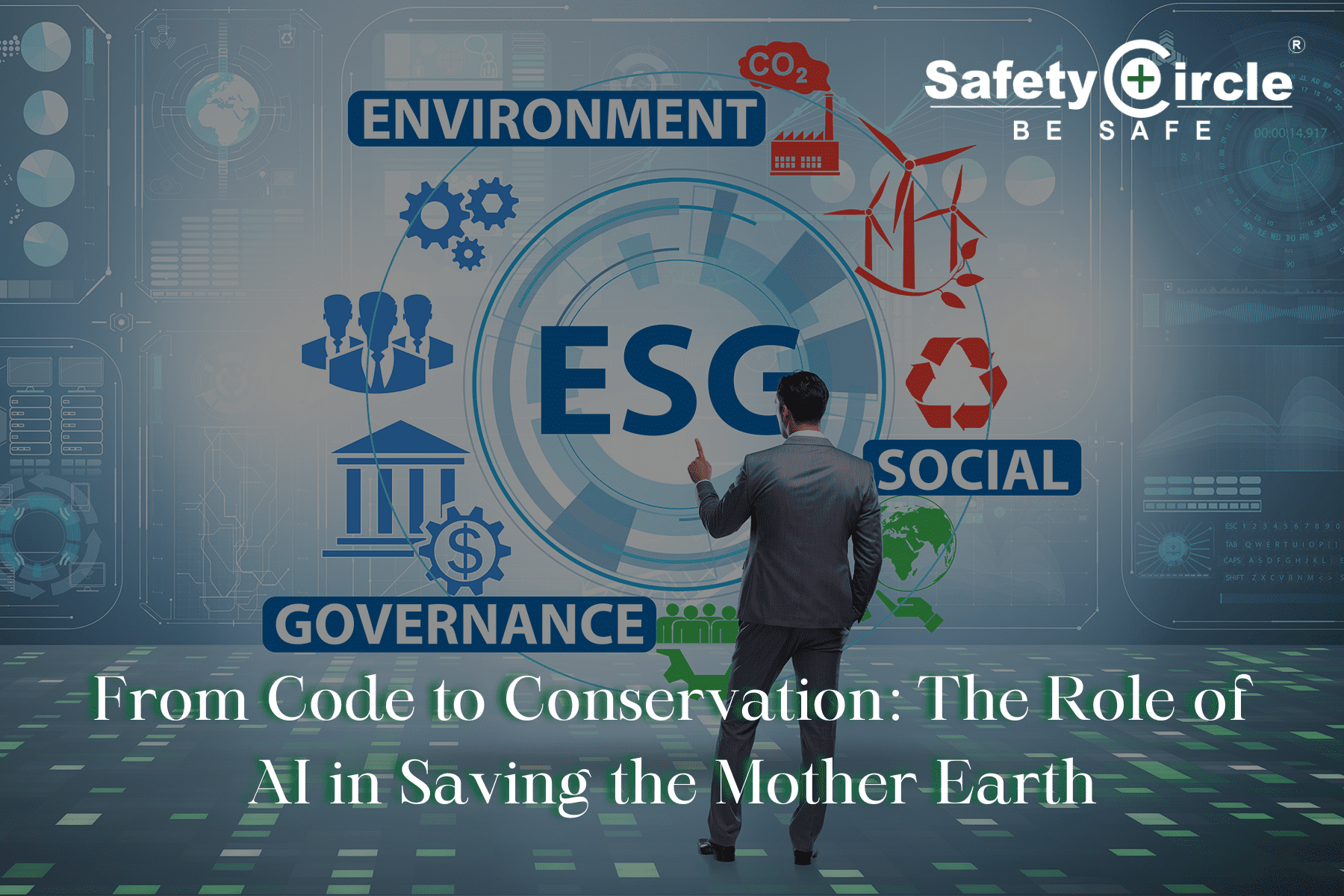INTRODUCTION:
Artificial Intelligence has taken over the entire world and has made inroads into almost every aspect of our lives, from conservation efforts to daily tasks. Whether it’s Alexa reminding us to switch off home appliances, AI articulating business proposals, or IBM Watson Health helping medical care providers develop personalized health plans, AI is changing the way we handle routine jobs. However, the most impactful role of Artificial Intelligence is fostering solutions to pressing environmental challenges such as climate change, habitat destruction, loss of biodiversity, and early warning of natural disasters, among many other applications.
Artificial Intelligence has the potential to revolutionize how we address the climate change crisis. AI helps in predicting the extreme weather events, optimizing the renewable energy system, provides insights regarding sustainable agricultural practices and carbon capture storage. A recent study found that AI might help in reducing global greenhouse gas emissions by 4% by 2030.
Role Of Artifical Intelligence In Environmental Conservation:
When it comes to conserving climate, we all know the fundamentals such as restricting the use of fossil fuels, transitioning towards cleaner energy sources, curbing the activities that are negatively impacting the environment, sustainable use of natural resources, and so forth. The challenge, thus, is not knowing “what to do” but “how to do it.” Climate Risks, being a global issue, require tailored solutions taking into account geographic, socio-economic and cultural disparities, and hence an innovative approach is required to cater to climate conservation. From monitoring ecosystems to predicting natural disasters, AI is transforming the approach adopted for solving some of the planet’s most urgent issues.
- Wildlife Monitoring and Innovations:
Artificial intelligence has revolutionized wildlife monitoring by providing innovative tools that can analyze large amounts of data more accurately and efficiently. The cameras used nowadays are equipped with AI powered sensors that can be used to track the movement of animals, identify the type of species, and can even detect poaching activities in real time. Cameras equipped with AI algorithms can differentiate between various species, which helps in accurate population assessment and helps to protect endangered species from illegal poaching activities.
- Satellite data for combating Deforestation:
Deforestation has been one of the major ESG concerns that is having a gruesome impact on various climate changing factors such as global warming, habitat loss, changes in precipitation cycle, soil erosion, etc. AI is playing a critical role in combating this issue. Satellite imagery is used globally to monitor deforestation activities. Machine learning algorithms can easily detect the changes in forest cover, illegal logging activities, and predict areas that are more vulnerable to deforestation. By providing real time data, AI helps the government and organizations to act swiftly and implement effective conservation strategies.
- Predicting and Managing Natural Disasters:
Artificial Intelligence is proving beneficial in predicting the harsh weather conditions and natural disasters such as hurricanes, floods, volcanic eruptions, famines, etc. By analyzing the historical data available in the datasets and evaluating the current scenarios, AI models are able to forecast the likelihood and impact of such events. For eg: AI algorithm can predict the tsunami buildup in the oceans, allowing for timely evacuation and deployment of natural disaster management teams. This proactive approach not only helps in saving lives, but also reduces the environmental damages.
- Advancing Climate Change Research:
Artificial intelligence is transforming climate change research by analyzing the complex models and large datasets. Machine learning algorithms are used to accurately identify patterns and correlations that were difficult to be identified by traditional methods. The advancements in this field help scientists and researchers to better understand the climate shift and predict future climate scenarios. This helps in developing better mitigation strategies. The AI driven models also help in analyzing the current impact of greenhouse gas emissions and thus, helps in guiding the development of risk mitigation policies.
- Sustainable Agriculture:
Agriculture has always been a victim as well as contributor to climate changes. Single breeds of agricultural crops deteriorate the soil condition. Excessive utilization of natural resources like water, is resulting in the decline in the groundwater table. Pesticides and fertilizers used during agriculture wash off to nearby water bodies, resulting in marine pollution. AI is helping in promoting sustainable agriculture by optimizing the use of natural resources and minimizing the environmental impact.
- Supporting Marine Conservation:
Oceans and Seas are vital for the global biodiversity and regulating the climate patterns. Underwater sensors, drones and satellite images powered by AI algorithms help in monitoring the marine ecosystem, health of coral reefs, and detect illegal fishing activities. AI algorithms can also predict the impact of climate changes on marine life, allowing for better conservation strategies.

Latest Developments:
- AI Driven Camera & Acoustic Monitoring: The new AI Algorithm cameras such as “Wild Me” are improving the accuracy and monitoring of wildlife. These cameras can identify and even recognize individual animals with high precision. The acoustic monitoring is carried out by using microphones that are placed in the natural habitat. These tools use AI to differentiate between different animal voices, thereby helping researchers track animal population and their behavior.
- AI Powered Satellite and Drone Technologies: Tools like “Global Forest Watch” utilizes AI powered satellite imagery to monitor deforestation, land use changes, and habitat destruction. Researchers are also using Drones that are equipped with machine learning algorithms. These drones fly autonomously and capture high resolution images which can be used to analyze the signs of environmental degradation.
- Climate Monitoring and Prediction: Various initiatives like “ClimateAI” use advanced machine learning techniques to predict climate changes and natural disasters. Businesses and governments worldwide use these models to make data driven decisions for mitigating the climate risks. “Carbon Track” is another such tool that is used to monitor the carbon emissions and track the carbon sequestration efforts.
- Sustainable Agriculture and Land use: There are various AI driven precision agriculture technologies that optimize the resource use by using drones, sensors or satellites data. “John Deere’s Sea and Spray” is a tool that targets weeds, helping farmers to apply pesticides more accurately. Tools like “Taranis”, utilizes AI algorithms to monitor soil conditions and predict crop health.
- AI Powered Marine Conservation: Artificial Intelligence is being used to monitor the marine ecosystem, health of coral reefs, and marine life. “OCEARCH” is a project that uses AI to analyze underwater sensors and satellite imagery for tracking the movement and behavior of marine animals. AI models can also forecast the movement of oil spills and plastic debris in oceans.
Conclusion:
The integration of AI into environmental conservation is driving significant advancements across various domains. Artificial Intelligence made its way into almost every aspect of climate risk mitigation, from wildlife monitoring and climate modeling to sustainable agriculture and marine conservation. To find out the public and private sectors leaders’ opinion on “Role of AI in Climate Conservation”, BCG conducted a survey of over 1000 executives and the key findings of the survey includes: 87% of the climate and AI leaders find AI as a powerful tool in the field of climate risk mitigation. Hence, we can conclude from available data that as these technologies evolve, their potential to drive positive change will expand further, offering new opportunities for mitigating the risks associated with climate change.




